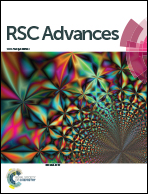Preparation of a nano-MnO2 surface-modified reduced graphene oxide/PVDF flat sheet membrane for adsorptive removal of aqueous Ni(ii)†
Abstract
In this paper, nanoscale MnO2 particles were attached onto the surface of a PVDF flat sheet membrane, step by step, first through dispersion of graphene oxide (GO) in the PVDF membrane, then reduction of immobilized GO by hydroiodic acid and further micro-wave assisted oxidation of RGO (reduced graphene oxide) by KMnO4 and formation of MnO2 on GO. The SEM observation revealed an asymmetric structure with a finger-like transition layer dominating the membrane of PVDF/MnO2. The uniform distribution of MnO2 on the membrane is revealed by EDX and XPS analysis. The attached MnO2 endowed the membrane with high adsorption capacity for aqueous Ni(II). The adsorption was spontaneous and endothermic, fitting a pseudo-first-order kinetic model and Freundlich isotherm model well. The pure water flux and stable permeation flux of the PVDF/MnO2 membrane reached 31.2 L m−2 h−1 and 9.0 L m−2 h−1 under 0.1 MPa, which were 2.3 and 2.6 times those of the PVDF membrane. The analysis of the fouling resistance and flux recovery ratio indicated that the PVDF/MnO2 membrane had better antifouling properties than the PVDF membrane, attributed to the changes of membrane morphologies and surface hydrophilicity. The PVDF/MnO2 membrane had a high removal ratio (≥87.4%) of Ni2+ in dynamic adsorption. Meanwhile the Ni(II) adsorbed membrane could be easily regenerated by a 0.1 M HNO3 solution.


 Please wait while we load your content...
Please wait while we load your content...